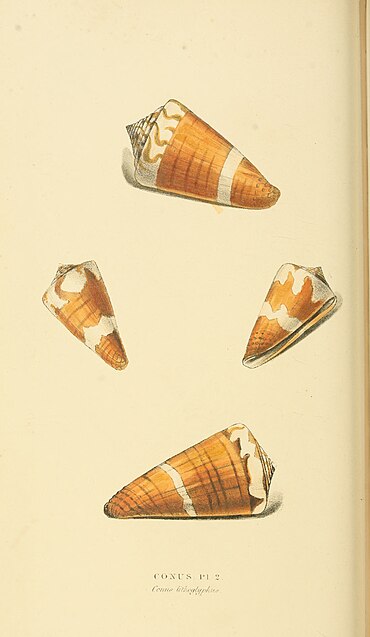Zoological Illustrations Series II/Plate 65
CONUS. Pl. 2.
Conus lithoglyphus.
CONUS lithoglyphus.
Ermine Cone.
Zoophaga. Family Strombidæ. Nob.
Operculum of the Animal smaller than the aperture of its shell; outer lip of the latter detached above.
Typical Genera. 1, Terebellum. 2, Strombus. 3, Conus. 4, ——? 5, Pleurotoma. Auct.
Generic Character. See Lam. Syst. 7, 440.
Specific Character.
Shell turbinated, redish orange, with two undulated white boards; base granulated, spire obtuse.
Conus lithoglyphus. Mus. Gevers. p. 350. Brug. Ency. Meth. p. 692. Lam. Syst. 7, 490. C. Ermineus, Dillwyn, 395.
Icones. Seba 3, pl. 42, f. 40, 41. Chem. pl. 140, f. 1298. Ency. Meth. pl. 338, f. 8.? Martini, 2, pl. 57, f. 630.—1.?
The Cone Shells belong to a predatious race of Molluscæ, who feed upon the innumerable "creeping things," which swarm in the prolific seas of the Oriental hemisphere: destitute both of jaws and lips, their mouth is formed into a long trunk or proboscis; with this they contrive to bore into solid shells, and suck the vital juices of their victims. Nearly all the species are natives of the Indian Ocean.
The circular system of Nature has been so fully demonstrated, that it must now be received as the first great truth in Natural History. As, therefore, there can be but one natural system, it necessarily follows that all combinations of groups, whether large or small, which do not pretend to exhibit such a disposition, must be more or less artificial classifications. We allude to this our opinion, as explanatory of those principles which have influenced the views indicated here of M. Cuviers Pectinibranchi; the more so, as we shall be obliged to characterize many new divisions, and to reform others, without the immediate opportunity of explaining our reasons. In another work we hope to enter on such details; and to shew we have been guided, in this matter, by more weighty considerations than mere individual opinion.
